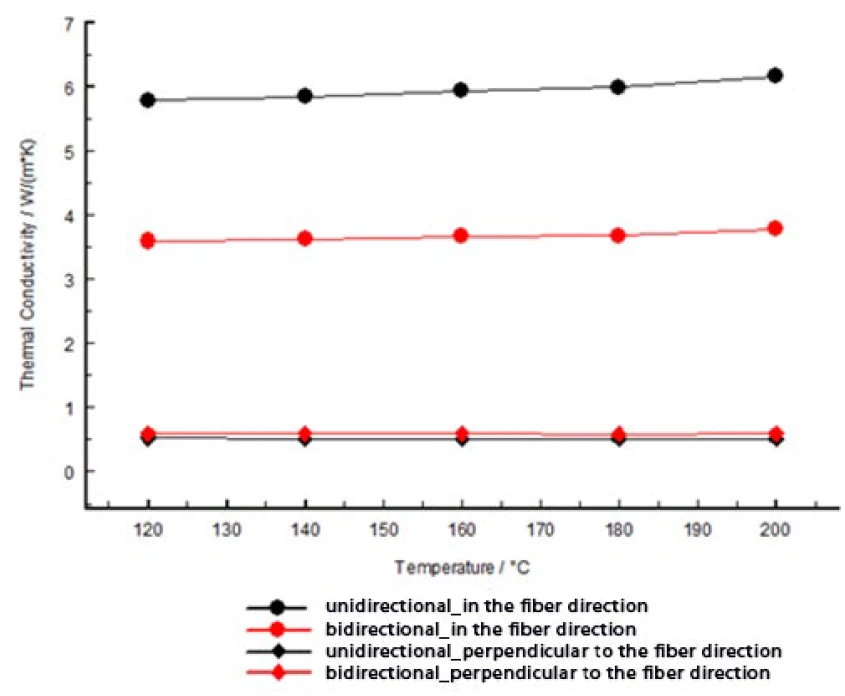Introduction
Fiber-reinforced plastics are light, yet they exhibit high stiffness. These properties make them useful as construction materials in the automotive industry. For optimizing process times during production, the Thermal ConductivityThermal conductivity (λ with the unit W/(m•K)) describes the transport of energy – in the form of heat – through a body of mass as the result of a temperature gradient (see fig. 1). According to the second law of thermodynamics, heat always flows in the direction of the lower temperature.thermal conductivity of these materials is an important property to monitor. It depends not only on temperature but on the orientation of the reinforcement material as well.
Using the LFA 467 HyperFlash®, the Thermal ConductivityThermal conductivity (λ with the unit W/(m•K)) describes the transport of energy – in the form of heat – through a body of mass as the result of a temperature gradient (see fig. 1). According to the second law of thermodynamics, heat always flows in the direction of the lower temperature.thermal conductivity of anistropic materials can easily and quickly be determined as a function of temperature in different spatial directions.
Samples and Experimental
A carbon fiber-reinforced epoxy resin was investigated which was unidirectionally* and bidirectionally** reinforced. The Thermal ConductivityThermal conductivity (λ with the unit W/(m•K)) describes the transport of energy – in the form of heat – through a body of mass as the result of a temperature gradient (see fig. 1). According to the second law of thermodynamics, heat always flows in the direction of the lower temperature.thermal conductivity was analyzed both parallel and perpendicular to the fiber direction. The measurements were carried out in a standard sample holder (12.7 mm square) between 120°C and 200°C in steps of 20 K. The specific heat was determined by means of the DSC 204 F1 Phoenix®.
* unidirectional: all fibers of the reinforcement material are parallel to each other
**bidirectional: the fibers of the reinforcement material are crossed at 0° and 90° angles
Results and Discussion
Depicted in figure 1 is the Thermal ConductivityThermal conductivity (λ with the unit W/(m•K)) describes the transport of energy – in the form of heat – through a body of mass as the result of a temperature gradient (see fig. 1). According to the second law of thermodynamics, heat always flows in the direction of the lower temperature.thermal conductivity of the unidirectionally (black) and bidirectionally (red) reinforced plastic samples. The unidirectionally reinforced sample, measured in the fiber direction (black dots) exhibited the highest Thermal ConductivityThermal conductivity (λ with the unit W/(m•K)) describes the transport of energy – in the form of heat – through a body of mass as the result of a temperature gradient (see fig. 1). According to the second law of thermodynamics, heat always flows in the direction of the lower temperature.thermal conductivity. The Thermal ConductivityThermal conductivity (λ with the unit W/(m•K)) describes the transport of energy – in the form of heat – through a body of mass as the result of a temperature gradient (see fig. 1). According to the second law of thermodynamics, heat always flows in the direction of the lower temperature.thermal conductivity of the bidirectionally reinforced sample, also measured in the fiber direction, was a bit lower. Due to the high Thermal ConductivityThermal conductivity (λ with the unit W/(m•K)) describes the transport of energy – in the form of heat – through a body of mass as the result of a temperature gradient (see fig. 1). According to the second law of thermodynamics, heat always flows in the direction of the lower temperature.thermal conductivity of the carbon fibers in the fiber direction (dots), thermal conductivities parallel to the fiber direction were 7 to 12 times higher than thermal conductivities perpendicular to the fiber direction (diamonds) for both samples. Measurements in the perpendicular direction yielded nearly the same Thermal ConductivityThermal conductivity (λ with the unit W/(m•K)) describes the transport of energy – in the form of heat – through a body of mass as the result of a temperature gradient (see fig. 1). According to the second law of thermodynamics, heat always flows in the direction of the lower temperature.thermal conductivity values for both samples, since the overall orientation of the fibers perpendicular to the direction of measurement have almost no influence.

Conclusion
A variety of sample holders has been developed for special measuring tasks by the LFA 467 Hyperflash, e.g., measurements on liquids, powders, thin metal foils, etc. Among these is a special lamiante sample holder employed for the investigations described here. Using this specially designed sample holder, the anistropy in the Thermal DiffusivityThermal diffusivity (a with the unit mm2/s) is a material-specific property for characterizing unsteady heat conduction. This value describes how quickly a material reacts to a change in temperature.thermal diffusivity of the carbon fiber-reinroced materials due to the orientation of the embedded fibers could be determined quickly and easily.